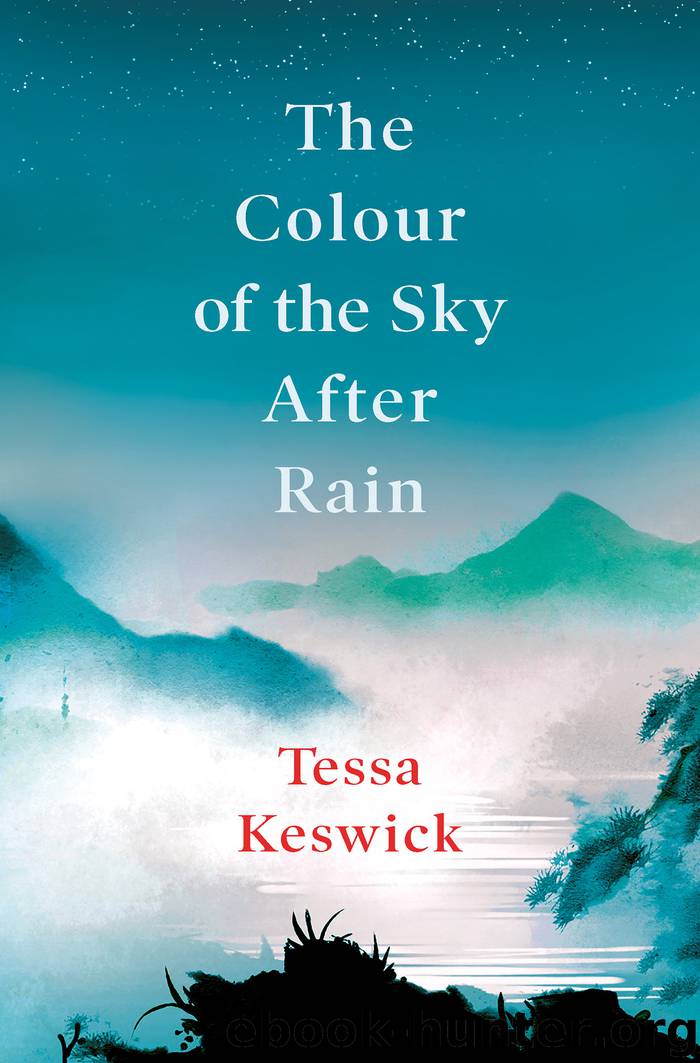The Colour of the Sky After Rain by Tessa Keswick

Author:Tessa Keswick [Keswick, Tessa]
Language: eng
Format: epub
ISBN: 9781789545043
Publisher: Head of Zeus
The band plays on in Shaxi’s Sideng market square; they produced an extraordinary wailing sound.
After a while we wander off to explore. Down the side streets the sturdily built stone houses remind me of Swiss or Austrian houses, solid stone but made partly of fretted woodwork with some visible carvings and decorative paintings in white and blue still intact. Venturing through the open door of one fine house, we find a fat cow tethered in the courtyard contentedly chewing the cud among a pile of bric-a-brac in the once elegant courtyard. The two-storey house has a charming wooden gallery on the first floor with rooms leading off. The kitchen door is wide open and inside this blackened room huge fire-scarred cauldrons are still in use. On the smoke-blackened walls a wooden cupboard holds a variety of desiccated implements, while smoke-cured hams and home-made sausages hang from the ceiling. A shaft of light coming from a high window illuminates the room and its few broken baskets. It was just as well the owners were at the joyous village celebration. We saw other houses like this as we explored the narrow village streets and listened to the clash of cymbals coming from the square. These dwellings once belonged to prosperous families. They might have been victims of the Cultural Revolution, which was particularly fierce in Yunnan, or of the earlier attacks against landlords under communism, reflected in the still lower standard of living in this southern part of the country.
After some hours of driving down picturesque roads through rolling country we see the majestic Jade Dragon Snow Mountain (Yulongxueshan) slowly coming into view, with its glistening glaciers reflected in the beautiful blue lake of Lashiba Hai. (Yulongxueshan is sometimes called Mount Satseto, after its Naxi name.) We climb slowly up the pass and then descend into the loveliness of the valley below. Eventually we see Lijiang, formerly centre of the ancient and forgotten Naxi kingdom, surrounded by mountains and still one of the great beauty spots of China. Once part of the ancient Southern Silk Road, which started in Burma and went through Tibet, Lijiang sits at nearly 8,000 feet, the snow-covered Yulongxueshan rising prominently behind it as a dramatic backdrop. Because of its great beauty Lijiang is sometimes thought to have been the inspiration for the original Shangri-La depicted by James Hilton in his 1933 utopian novel, Lost Horizon.
In the novel a plane from India crash-lands in the hostile mountains of Tibet. The survivors make their way through the perilous terrain and find refuge in a lamasery, where their lives are changed for ever. There remains a mystery as to the actual origins of the utopian lamasery of Shangri-La described in the novel and where this paradise is meant to be. We know that James Hilton admired Dr Joseph Rock, the distinguished explorer, linguist and botanist who lived for years in a traditional house in Yuhu village near Lijiang. Whether Hilton actually visited Rock in this home, only 123 miles from the border of Tibet, is not known.
Download
This site does not store any files on its server. We only index and link to content provided by other sites. Please contact the content providers to delete copyright contents if any and email us, we'll remove relevant links or contents immediately.
Deng Xiaoping and the Transformation of China by Vogel Ezra F(846)
Big Sister, Little Sister, Red Sister by Jung Chang(744)
The Great Road by Smedley Agnes;(561)
Escape From the Land of Snows: The Young Dalai Lama's Harrowing Flight to Freedom and the Making of a Spiritual Hero by Stephan Talty(383)
Stilwell & the American Experience in China 1911-45 by Barbara Tuchman(344)
Chiang Kai Shek by Jonathan Fenby(337)
No Wall Too High by Xu Hongci(323)
Spider Eaters by Yang Rae(282)
The Unfinished Revolution by Tjio Kayloe(281)
Hong Kong Police: Inside the Lines by Chris Emmett(276)
The Colour of the Sky After Rain by Tessa Keswick(273)
Hong Kong Holiday by Emily Hahn(270)
Li Shi Min, Founding the Tang Dynasty by Hing Ming Hung(266)
The Last Empress by Hannah Pakula(264)
Prisoner of the State by Bao Pu Renee Chiang & Adi Ignatius(249)
Generalissimo by Jonathan Fenby(248)
Exemplary Women of Early China by Anne Behnke Kinney(244)
